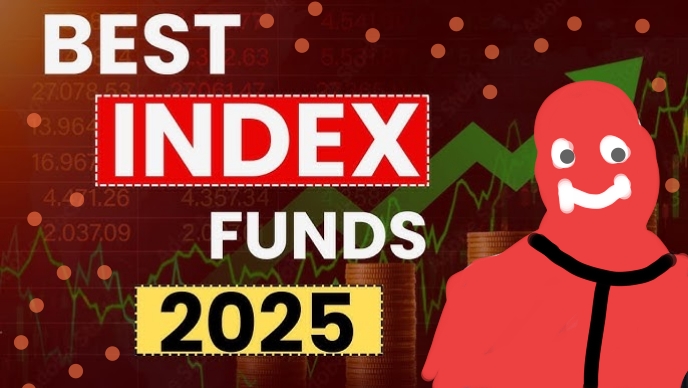Investing can feel like navigating a maze, especially with so many options available. For many Americans, the choice often boils down to two popular paths: index funds or individual stocks. As we head into 2025, understanding the pros, cons, and nuances of each can help you make smarter decisions for your financial future. This article breaks down the differences between index funds and stocks, explores their risks and rewards, and offers guidance on which might be your best bet for 2025. Whether you’re a beginner or a seasoned investor, this guide is designed to be clear, practical, and tailored to the U.S. market.
𝟭. 𝗪𝗵𝗮𝘁 𝗔𝗿𝗲 𝗜𝗻𝗱𝗲𝘅 𝗙𝘂𝗻𝗱𝘀 𝗮𝗻𝗱 𝗦𝘁𝗼𝗰𝗸𝘀?
Before diving into which option is better, let’s clarify what index funds and stocks are.
𝘿𝙚𝙛𝙞𝙣𝙞𝙣𝙜 𝙄𝙣𝙙𝙚𝙭 𝙁𝙪𝙣𝙙𝙨
An index fund is a type of mutual fund or exchange-traded fund (ETF) designed to track the performance of a specific market index, like the S&P 500 or the Nasdaq. Instead of picking individual stocks, an index fund holds a basket of stocks that mirrors the index it follows. For example, an S&P 500 index fund invests in all 500 companies in the S&P 500, giving you broad exposure to the U.S. stock market.
𝘿𝙚𝙛𝙞𝙣𝙞𝙣𝙜 𝙎𝙩𝙤𝙘𝙠𝙨
Stocks represent ownership in a single company. When you buy a share of stock, you own a small piece of that business. If the company does well, the stock price may rise, and you could earn dividends. But if the company struggles, the stock price can drop, and you might lose money. Stocks are traded on exchanges like the New York Stock Exchange (NYSE) or Nasdaq.
𝟮. 𝗛𝗼𝘄 𝗜𝗻𝗱𝗲𝘅 𝗙𝘂𝗻𝗱𝘀 𝗪𝗼𝗿𝗸
𝙏𝙝𝙚 𝙈𝙚𝙘𝙝𝙖𝙣𝙞𝙘𝙨 𝙤𝙛 𝙄𝙣𝙙𝙚𝙭 𝙁𝙪𝙣𝙙𝙨
Index funds are passively managed, meaning they aim to replicate the performance of an index rather than beat it. A fund manager buys the same stocks in the same proportions as the index. For example, if Apple makes up 6% of the S&P 500, an S&P 500 index fund will allocate 6% of its assets to Apple. Because there’s no active stock picking, index funds typically have low fees.
𝙋𝙤𝙥𝙪𝙡𝙖𝙧 𝙄𝙣𝙙𝙚𝙭 𝙁𝙪𝙣𝙙𝙨 𝙞𝙣 𝙩𝙝𝙚 𝙐.𝙎.
Some of the most popular index funds for U.S. investors include:
✓ Vanguard S&P 500 ETF (VOO): Tracks the S&P 500, with a low expense ratio (around 0.03%).
✓ iShares Core MSCI Total International Stock ETF (IXUS): Tracks global stocks outside the U.S.
✓ Schwab U.S. Small-Cap ETF (SCHA): Focuses on smaller U.S. companies. These funds are available through brokerages like Vanguard, Fidelity, or Charles Schwab.
𝟯. 𝗛𝗼𝘄 𝗦𝘁𝗼𝗰𝗸𝘀 𝗪𝗼𝗿𝗸
𝘽𝙪𝙮𝙞𝙣𝙜 𝙖𝙣𝙙 𝙊𝙬𝙣𝙞𝙣𝙜 𝙄𝙣𝙙𝙞𝙫𝙞𝙙𝙪𝙖𝙡 𝙎𝙩𝙤𝙘𝙠𝙨
When you buy a stock, you’re purchasing a share of a company like Apple, Tesla, or Walmart. You can buy stocks through a brokerage account, such as Robinhood, E*TRADE, or TD Ameritrade. The stock’s value fluctuates based on the company’s performance, market conditions, and investor sentiment. You can make money through capital gains (selling the stock for more than you paid) or dividends (cash payments some companies make to shareholders).
𝙏𝙮𝙥𝙚𝙨 𝙤𝙛 𝙎𝙩𝙤𝙘𝙠𝙨
✓ Growth Stocks: Companies expected to grow quickly, like tech firms (e.g., Nvidia or Amazon). They often reinvest profits rather than pay dividends.
✓ Value Stocks: Undervalued companies with strong fundamentals, often in traditional industries like banking or energy.
✓Dividend Stocks: Companies that pay regular dividends, like Coca-Cola or Procter & Gamble, appealing to income-focused investors.
𝟰. 𝗞𝗲𝘆 𝗗𝗶𝗳𝗳𝗲𝗿𝗲𝗻𝗰𝗲𝘀 𝗕𝗲𝘁𝘄𝗲𝗲𝗻 𝗜𝗻𝗱𝗲𝘅 𝗙𝘂𝗻𝗱𝘀 𝗮𝗻𝗱 𝗦𝘁𝗼𝗰𝗸𝘀
To decide which is better for 2025, let’s compare index funds and stocks across key factors.
𝘿𝙞𝙫𝙚𝙧𝙨𝙞𝙛𝙞𝙘𝙖𝙩𝙞𝙤𝙣
✓ Index Funds: Offer instant diversification by holding hundreds or thousands of stocks. For example, one share of an S&P 500 ETF gives you exposure to 500 companies across industries.
✓ Stocks: Limited diversification unless you buy many stocks. Owning just a few stocks exposes you to company-specific risks.
𝙍𝙞𝙨𝙠 𝙖𝙣𝙙 𝙑𝙤𝙡𝙖𝙩𝙞𝙡𝙞𝙩𝙮
✓ Index Funds: Lower risk because they spread investments across many companies. If one company fails, the impact on the fund is minimal.
✓ Stocks: Higher risk since your investment is tied to one company’s performance. A single bad earnings report can tank a stock’s price.
𝙏𝙞𝙢𝙚 𝙖𝙣𝙙 𝙀𝙛𝙛𝙤𝙧𝙩
✓ Index Funds: Require minimal effort. You buy the fund and let it track the index. No need to research individual companies.
✓ Stocks: Demand research and monitoring. You need to analyze company financials, market trends, and news to make informed decisions.
𝘾𝙤𝙨𝙩𝙨 𝙖𝙣𝙙 𝙁𝙚𝙚𝙨
✓ Index Funds: Low fees, often with expense ratios below 0.1%. For example, a $10,000 investment in a fund with a 0.03% expense ratio costs just $3 annually.
✓ Stocks: No ongoing fees, but you may pay trading commissions (though many brokerages now offer commission-free trading). However, buying enough stocks to diversify can be costly.
𝟱. 𝗣𝗿𝗼𝘀 𝗮𝗻𝗱 𝗖𝗼𝗻𝘀 𝗼𝗳 𝗜𝗻𝗱𝗲𝘅 𝗙𝘂𝗻𝗱𝘀
𝘼𝙙𝙫𝙖𝙣𝙩𝙖𝙜𝙚𝙨 𝙤𝙛 𝙄𝙣𝙙𝙚𝙭 𝙁𝙪𝙣𝙙𝙨
✓ Diversification: Reduces risk by spreading investments across many companies.
✓ Low Costs: Expense ratios are often under 0.2%, making them cost-effective.
✓ Simplicity: Ideal for hands-off investors who don’t want to research stocks.
✓ Consistent Returns: Historically, index funds like those tracking the S&P 500 have delivered average annual returns of 7-10% over the long term.
✓ Accessibility: You can start with small amounts, as many funds have low or no minimums.
𝘿𝙞𝙨𝙖𝙙𝙫𝙖𝙣𝙩𝙖𝙜𝙚𝙨 𝙤𝙛 𝙄𝙣𝙙𝙚𝙭 𝙁𝙪𝙣𝙙𝙨
✓ Limited Upside: You’re unlikely to “beat the market” since index funds aim to match, not exceed, the index’s performance.
✓ No Control: You can’t pick specific stocks within the fund.
✓ Market Risk: If the entire market drops, your index fund will too.
✓ Dividends Vary: Some index funds pay dividends, but the yield may be lower than individual dividend stocks.
𝟲. 𝗣𝗿𝗼𝘀 𝗮𝗻𝗱 𝗖𝗼𝗻𝘀 𝗼𝗳 𝗦𝘁𝗼𝗰𝗸𝘀
𝘼𝙙𝙫𝙖𝙣𝙩𝙖𝙜𝙚𝙨 𝙤𝙛 𝙎𝙩𝙤𝙘𝙠𝙨
✓ High Potential Returns: A single stock can skyrocket if the company performs well (e.g., Tesla’s massive gains in the 2020s).
✓ Control: You choose which companies to invest in based on your research or preferences.
✓ Dividends: Some stocks offer steady income through dividends, which can be reinvested or used as cash flow.
✓ Flexibility: You can buy or sell stocks quickly to capitalize on market opportunities.
𝘿𝙞𝙨𝙖𝙙𝙫𝙖𝙣𝙩𝙖𝙜𝙚𝙨 𝙤𝙛 𝙎𝙩𝙤𝙘𝙠𝙨
✓ High Risk: Individual stocks are volatile, and a single bad decision can lead to significant losses.
✓ Time-Intensive: Requires ongoing research to pick winners and monitor performance.
✓ Lack of Diversification: Unless you invest in many stocks, your portfolio is vulnerable to company-specific risks.
✓ Emotional Stress: Stock price swings can be nerve-wracking, leading to impulsive decisions.
𝟳. 𝗪𝗵𝘆 𝟮𝟬𝟮𝟱 𝗠𝗮𝘁𝘁𝗲𝗿𝘀 𝗳𝗼𝗿 𝗜𝗻𝘃𝗲𝘀𝘁𝗼𝗿𝘀
𝙀𝙘𝙤𝙣𝙤𝙢𝙞𝙘 𝙊𝙪𝙩𝙡𝙤𝙤𝙠 𝙛𝙤𝙧 2025
As we approach 2025, the U.S. economy faces a mix of opportunities and uncertainties. The Federal Reserve’s interest rate policies, inflation trends, and global economic conditions will influence markets. Recent data suggests inflation is stabilizing, but potential rate cuts or hikes could impact stock and index fund performance. Sectors like technology, renewable energy, and healthcare are expected to drive growth, while geopolitical tensions and supply chain issues could create volatility.
𝙈𝙖𝙧𝙠𝙚𝙩 𝙏𝙧𝙚𝙣𝙙𝙨 𝙩𝙤 𝙒𝙖𝙩𝙘𝙝
✓ Tech Dominance: Tech giants like Apple, Microsoft, and Nvidia continue to lead the S&P 500, benefiting index fund investors.
✓ Small-Cap Opportunities: Small-cap stocks may outperform in 2025 if interest rates decline, favoring individual stock pickers.
✓ Sustainable Investing: ESG (Environmental, Social, Governance) index funds and stocks are gaining traction among younger investors.
✓ Dividend Demand: With potential market uncertainty, dividend-paying stocks and funds may attract income-focused investors.
𝟴. 𝗪𝗵𝗶𝗰𝗵 𝗜𝘀 𝗕𝗲𝘁𝘁𝗲𝗿 𝗳𝗼𝗿 𝗬𝗼𝘂 𝗶𝗻 𝟮𝟬𝟮𝟱?
Your choice depends on your goals, risk tolerance, and time commitment.
𝙁𝙤𝙧 𝘽𝙚𝙜𝙞𝙣𝙣𝙚𝙧𝙨
✓ Best Choice: Index Funds
✓ Why: Index funds are a low-cost, low-effort way to start investing. They provide diversification and reduce the risk of picking the wrong stocks. A fund like the Vanguard S&P 500 ETF (VOO) is a great entry point for new investors.
𝙁𝙤𝙧 𝙀𝙭𝙥𝙚𝙧𝙞𝙚𝙣𝙘𝙚𝙙 𝙄𝙣𝙫𝙚𝙨𝙩𝙤𝙧𝙨
✓ Best Choice: Stocks (with some index funds)
✓ Why: If you enjoy researching companies and have the time to analyze financials, individual stocks offer the potential for higher returns. However, even experienced investors often use index funds as a “core” holding to balance risk.
𝙁𝙤𝙧 𝙍𝙚𝙩𝙞𝙧𝙚𝙢𝙚𝙣𝙩 𝙎𝙖𝙫𝙚𝙧𝙨
✓ Best Choice: Index Funds
✓ Why: For long-term goals like retirement, index funds provide steady growth with minimal risk. Target-date index funds, which adjust risk as you approach retirement, are popular in 401(k) plans.
𝟵. 𝗛𝗼𝘄 𝘁𝗼 𝗚𝗲𝘁 𝗦𝘁𝗮𝗿𝘁𝗲𝗱
𝙄𝙣𝙫𝙚𝙨𝙩𝙞𝙣𝙜 𝙞𝙣 𝙄𝙣𝙙𝙚𝙭 𝙁𝙪𝙣𝙙𝙨
✓ Open a Brokerage Account: Use platforms like Vanguard, Fidelity, or Robinhood.
✓ Choose a Fund: Look for low-cost funds like VOO or SCHB (Schwab U.S. Broad Market ETF).
✓ Set Up Automatic Investments: Contribute monthly to take advantage of dollar-cost averaging.
✓ Reinvest Dividends: This compounds your returns over time.
𝙄𝙣𝙫𝙚𝙨𝙩𝙞𝙣𝙜 𝙞𝙣 𝙎𝙩𝙤𝙘𝙠𝙨
✓ Open a Brokerage Account: Many offer commission-free trading.
✓ Research Stocks: Use tools like Yahoo Finance, Morningstar, or Seeking Alpha to analyze companies.
✓ Diversify: Aim to own 10-20 stocks across different sectors.
✓ Monitor Your Portfolio: Stay updated on company news and earnings reports.
𝟭𝟬. 𝗧𝗮𝘅 𝗖𝗼𝗻𝘀𝗶𝗱𝗲𝗿𝗮𝘁𝗶𝗼𝗻𝘀 𝗳𝗼𝗿 𝗨.𝗦. 𝗜𝗻𝘃𝗲𝘀𝘁𝗼𝗿𝘀
𝙏𝙖𝙭𝙚𝙨 𝙤𝙣 𝙄𝙣𝙙𝙚𝙭 𝙁𝙪𝙣𝙙𝙨
✓ Capital Gains: If you sell shares of an index fund for a profit, you’ll owe capital gains tax (15-20% for long-term gains, depending on income).
✓ Dividends: Many index funds pay dividends, taxed as ordinary income or at a qualified dividend rate (0-20%).
✓ ETFs vs. Mutual Funds: ETFs are often more tax-efficient due to lower capital gains distributions.
𝙏𝙖𝙭𝙚𝙨 𝙤𝙣 𝙎𝙩𝙤𝙘𝙠𝙨
✓ Capital Gains: Similar to index funds, profits from selling stocks are taxed based on holding period.
✓ Dividends: Qualified dividends from stocks are taxed at favorable rates, but non-qualified dividends are taxed as ordinary income.
✓ Tax-Loss Harvesting: Selling losing stocks to offset gains can reduce your tax bill.
Consult a tax professional to optimize your strategy, especially if investing through a taxable account.
𝟭𝟭. 𝗖𝗼𝗺𝗺𝗼𝗻 𝗠𝗶𝘀𝘁𝗮𝗸𝗲𝘀 𝘁𝗼 𝗔𝘃𝗼𝗶𝗱
✓ Chasing Hot Stocks: Buying stocks based on hype (e.g., meme stocks) can lead to losses.
✓ Ignoring Fees: High expense ratios in some index funds can erode returns.
✓ Market Timing: Trying to predict market highs and lows often backfires. Stick to a long-term plan.
✓ Lack of Diversification: Over-investing in one stock or sector increases risk.
✓ Emotional Investing: Panic-selling during market dips or buying during euphoria can hurt returns.
𝟭𝟮. 𝗖𝗼𝗻𝗰𝗹𝘂𝘀𝗶𝗼𝗻: 𝗠𝗮𝗸𝗶𝗻𝗴 𝗬𝗼𝘂𝗿 𝗖𝗵𝗼𝗶𝗰𝗲 𝗳𝗼𝗿 𝟮𝟬𝟮𝟱
Both index funds and stocks have a place in a well-rounded investment strategy, but your choice for 2025 depends on your goals and comfort level. Index funds are ideal for most U.S. investors, offering simplicity, low costs, and diversification. They’re especially suited for beginners, busy professionals, or those saving for long-term goals like retirement. Stocks, on the other hand, appeal to those willing to take on more risk and effort for the chance of higher returns.
For 2025, a balanced approach might be best: use index funds as the foundation of your portfolio for stability and add a small allocation to individual stocks for growth potential. Whatever you choose, start early, stay consistent, and avoid common pitfalls. With the U.S. market poised for both opportunities and challenges in 2025, now’s the time to take control of your financial future.

